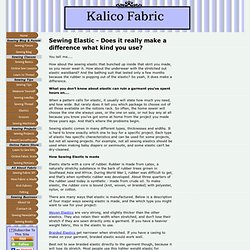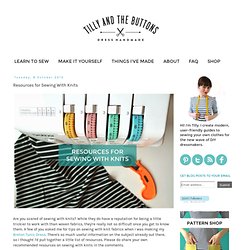

Diy spray starch: no curled edges. Look familiar?

: Knit jersey is GREAT (yea? Nay?) , but, you know, it has some characteristics that can bug the hell out of us seamsters. The raw edges don't fray, but they do curl. I don't know what you people do/don't know, but I thought I'd go ahead and share a new-to-me discovery of a way to keep those roley-poley edges in check. Certainly you can buy some fabric starch spray at your local grocery store or whatever, but I decided to go au naturel and make my own. Distilled water (in case you have hard tap water with high mineral content that can damage your iron or possibly your fabric)Corn starchEmpty plastic spray bottle. I used 1 cup (240 mL) of distilled water: and 4 level teaspoons (20 mL) of corn starch: You may want to use less corn starch to test first, and I think it also depends on the fabric content and weight.
Mix these ingredients in a bowl or something that will be easy to pour from. Pour into your spray bottle, reattach the nozzle and give it a good shake. Tips and Care for Sewing Elastic. Sewing Elastic Types. You tell me....

How about the sewing elastic that bunched up inside that skirt you made, so you never wear it. How about the underwear with the stretched out elastic waistband? And the bathing suit that lasted only a few months because the rubber is popping out of the elastic? So yeah, it does make a difference. What you don’t know about elastic can ruin a garment you’ve spent hours on…. When a pattern calls for elastic, it usually will state how much you need, and how wide. Sewing elastic comes in many different types, thicknesses and widths. How Sewing Elastic is made Elastic starts with a core of rubber. There are many ways that elastic is manufactured. Woven Elastics are very strong, and slightly thicker than the other elastics. Braided Elastics get narrower when stretched.
Best not to sew braided elastic directly to the garment though, because it will lose its stretch. Non-Roll Elastic is especially appropriate for use in waistbands, because it stays flat when stretched. Lycra info (see comments) Remember these? Those pants that fit so nicely? Well, soon after I blogged about them I discovered that after about an hour of sitting, they looked less like that and more like I was trying to beat Eminem in a baggy pants competition. No, I did not photograph my butt in baggy pants for you. This has been a long-time issue for me. Jeans that fit in the store would stretch out to be two sizes too big. Now that I'm making my own pants, I feel like I should have more control over this issue.
In the case of my red pants, I pinched out the excess left after a day of sitting, unpicked the waistband at the side seams only, removed said excess fabric at the outside sideseams (I was not going to mess with the inside seams and crotch curve), and tried them on. I would love to avoid having to make and unmake pants in the future in order to deal with this. Sewing with knits. I get a lot of comments after I do a post involving sewn knit fabric.

A lot of the wow, you sew knit fabrics kind of comments. Sewing with Jersey & Knits (Links) I collect useful links.

It’s my thing. And now that I’m embarking on some sewing projects which will work better with some of those piles of information readily at hand and tidily organized, it seems that I might as well do that organizing on here, so anyone else with an obsessive desire to research 97 different ways to do something can also partake of my linkful bounty. Now, obviously the subject of sewing with jersey and other knit fabrics does not have a great deal to do with historical sewing, but many twentieth century styles involve knit fabrics, plus knits can be used for modern interpretations of even more styles, as well as for current designs.
I love many mid-twentieth-century vintage styles as well as true historical costumes (you know, really old stuff), and I’ve found that I can get away with wearing 1950s styles in everyday life, which is not so much the case for, say, 1850s. And sometimes a girl just needs a T-shirt. Handling knits (totally stable interfacing) I've been sewing on some knit fabrics that present challenges, here are some ways I workaround them.

This linen knit shown here is gorgeous, has a fabulous drape and a very appealing pure linen texture. It is also semi sheer, light weight, has some rolling at the cut edge and the biggest problem is that it does not have good recovery, which means that when stitched on the cross grain it stretches easily. The lengthwise grain is not such a problem. Resources for Sewing With Knits. Are you scared of sewing with knits?

While they do have a reputation for being a little trickier to work with than woven fabrics, they're really not so difficult once you get to know them. A few of you asked me for tips on sewing with knit fabrics when I was making my Breton Tunic Dress. There's so much useful information on the subject already out there, so I thought I'd pull together a little list of resources. Please do share your own recommended resources on sewing with knits in the comments. Blogs There are some brilliant blog posts out there, including: - Mad Mim's great 'Stretch Yourself' series, which is jam-packed with useful tips and tricks - Lauren's no nonsense introduction to the topic - Dixie DIY's guide to sewing her ballet dress pattern - Tasia Sewaholic's posts on sewing the Renfrew top - Steph's posts such as stabilising seams.
Classes Books As for books, I love Sew U Home Stretch by Wendy Mullin for an introduction to techniques plus some nice staple knit projects to try. Stabilizing knits (stay tape, elastic, interfacing) (top: stay tape, middle: clear elastic, bottom: regular elastic) Thanks for following along with the series so far! Today we're talking support systems - stabilizers, elastic, interfacing, etc. To recap, you can read all the Never Fear Knits posts here. InterfacingOccasionally you'll come across a knit pattern that requires interfacing - think wide waistbands on jersey dresses. Yes, they do make knit interfacing and yes, it does stretch.
You'll find it in the store mixed in with the rest of the interfacings. Stay Tape Even though knits stretch there are certain parts of knit garments that you don't want to stretch out - like shoulder seams. Elastic For waists of dresses you'll probably need some elastic to maintain the shape. If you want the waistband to lay flat you'll cut your elastic the length of the waist measurement of the dress.